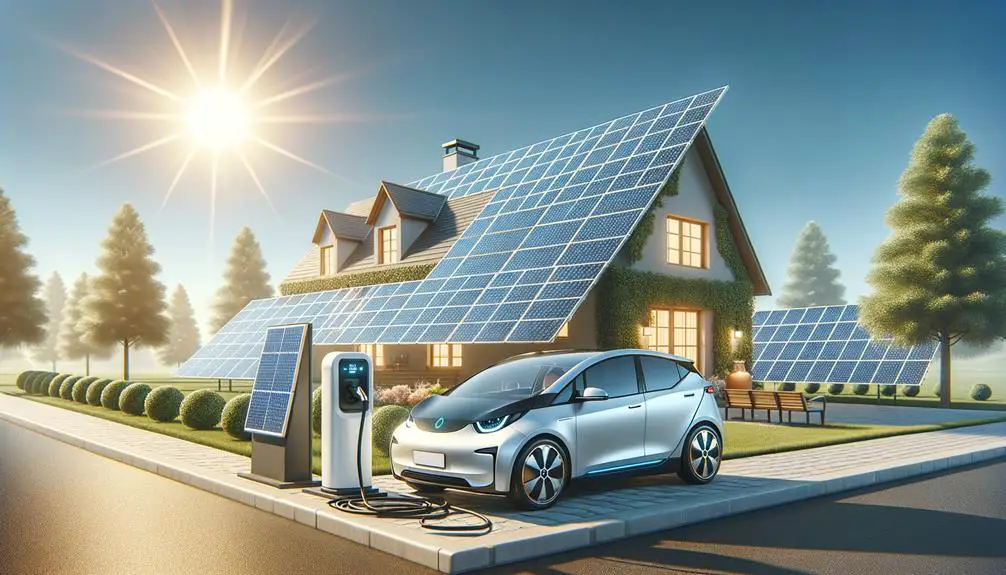How Many Solar Panels to Charge an Electric Car: Calculation Simplified
I am researching how many solar panels to charge an electric car are required to keep my vehicle fully charged and ready to navigate the roads.
It’s a complex equation, blending the daily mileage I cover with the fluctuating generosity of the sun and the varying energy yields of solar panels. The capacity of my car’s battery and the solar panel efficiency are critical variables in this calculation.
I stand at the intersection of technology and sustainability, and I’m eager to share my findings on how to power electric vehicles with clean, green solar energy.
There’s much to consider, from roof space to local weather patterns, and I invite you to join me in uncovering the practicalities of this renewable synergy that could redefine how we think about transportation and energy consumption.
Continue Reading to Understand These Key Points:
- Electric vehicles have specific energy consumption metrics, such as miles per kWh (Mi/kWh).
- Solar panel output is a critical factor to consider, with a typical 360W panel generating approximately 1.62 kWh per day.
- Solar panel efficiency plays a crucial role in determining the number of panels required to meet the energy demands of charging an electric vehicle.
- Comparing the total kWh of electricity needed for daily charging to the expected daily kWh output of the home solar system helps determine the number of panels required.
Understanding EV Energy Requirements
To accurately determine the number of solar panels needed to charge an electric vehicle, one must first comprehend the vehicle’s energy consumption, expressed in terms such as miles per kWh (Mi/kWh). This metric is pivotal for calculating the EV’s energy needs.
If my electric car has an efficiency of 4 Mi/kWh, and I drive an average of 40 miles per day, my EV charging requirements would be 10 kWh per day. Now I assess my solar panel output:
A typical 360W panel under optimal conditions generates roughly 1.62 kWh per day (360 watts x 4.5 hours of sunlight).
To meet my electric car’s kWh per day needs, I’d need about 6.17 solar panels. But you always have to consider variables like panel orientation, weather fluctuations, and the efficiency of the inverter, I’ll round up to ensure I don’t undersize my system.
After completing my calculation, I opt for 7 solar panels to accommodate my EV charging requirements and provide a small buffer.
Calculating Solar Panel Needs
Calculating the precise number of solar panels needed to charge an electric vehicle requires an analytical approach to evaluate daily electricity consumption and solar panel output. I delve into the specifics by considering:
- The EV battery’s kWh of energy per mile
- The daily mileage
- The average peak sun hours in my area
- The wattage and efficiency of the solar panels I’m planning to use
To engage in an accurate calculation, I must factor in:
- Daily EV Energy Requirements:
- Determine kWh used per mile
- Multiply by the average daily miles driven
- Solar Panel Output:
- Calculate daily output in kWh (panel wattage x peak sun hours)
- Adjust for panel efficiency
I’m aware that variations in panel wattage and local sun exposure can significantly affect the number of panels needed. For instance, with a 360W panel and an average of 4.5 peak sun hours, the output per panel is roughly 1.62 kWh per day.
If my EV consumes 0.3 kWh per mile and I drive 30 miles a day, I need approximately 9 kWh. Therefore, I’d need about six solar panels to charge my EV battery daily, considering the system’s efficiency.
Solar Panel Efficiency Considerations
Understanding solar panel efficiency is crucial as it directly affects the number of panels required to meet the energy demands of charging an electric vehicle. Solar panel efficiency relates to the ability of the panels to convert sunlight into usable electricity.
Therefore, when calculating the energy production necessary to charge my electric car, I must consider not only the panel wattage but also the average daily sun hours available in my location.

Efficient solar panels can significantly reduce the overall number of panels needed. For instance, if a less efficient panel produces less energy per square foot, I’d need more panels to achieve the same output as fewer high-efficiency panels.
This efficiency is dependent on factors including the manufacturing technology and the quality of materials used.
To accurately determine my solar array size, I analyze my car’s average daily range, the energy consumption rates, and the expected sun hours in my area. By dividing my desired energy production by the efficiency and wattage of the panels, I can estimate the number required for my electric vehicle’s needs.
It’s a precise balance: high solar panel efficiency leads to fewer panels, reduced space requirements, and potentially lower installation costs in the long run.
Sizing Your Home Solar System
When sizing a home solar system for electric vehicle charging, I must meticulously assess my car’s energy consumption against the expected solar energy production from my panels. To determine the solar panels needed to charge my electric car, I follow a technical and analytical approach. Here’s a breakdown:
Daily Driving Habits:
- Average miles driven per day
- kWh of electricity consumed per mile
Solar Energy Production:
- Peak wattage of each solar panel
- Expected daily kWh production per panel
I consider my vehicle’s fuel efficiency rating, which directly impacts how much energy I’ll need to charge it. For an energy efficient electric car, fewer panels may suffice. Conversely, a less efficient vehicle will require more panels.
I calculate the total kWh of electricity needed for my daily commute and compare that to the expected daily kWh output of my home solar system, factoring in sunlight hours and panel efficiency.
It’s not just about the solar panels themselves. I also account for ancillary components and system scalability to ensure I have a complete solution that can adapt to my future energy needs.
This precise planning helps me build a home solar system that’s both cost-effective and sustainable in the long term.
Solar Charging Vs. Grid Charging
After a meticulous analysis of my car’s energy needs and my home solar system’s capacity, I now compare the advantages and drawbacks of charging my electric vehicle using solar power versus traditional grid electricity.
Solar charging leverages renewable energy, which is pivotal for long-term sustainability and energy efficiency. Conversely, grid charging, while reliable, often depends on non-renewable sources, posing environmental concerns. Solar panels provide a self-sufficient charging ecosystem for my electric vehicle, detached from the volatility of grid electricity prices.

Here’s a technical breakdown to add depth:
| Factor | Solar Charging | Grid Charging |
|---|---|---|
| Energy Source | Renewable, reduces carbon footprint | High after the initial investment |
| Cost-Effectiveness | Depending on weather, daylight hours | Variable, subject to energy market rates |
| Reliability | Depending on the weather, daylight hours | Consistent availability, less weather-dependent |
Solar charging vs. grid charging presents a trade-off between upfront costs and long-term benefits. Solar panels require significant initial investment but offer greater control over energy efficiency and cost. Grid charging, although immediate and consistent, might not match the environmental ethos I’ve established for my lifestyle.
This means that the choice hinges on balancing ecological impact with economic and practical considerations.
Final Thoughts
In my journey, each solar panel is a green leaf on the tree of sustainability, transforming sunlight into the lifeblood of my electric steed.
Precisely tailoring my solar array to meet my car’s appetite for energy, I’ve found a symphony in the sun’s rays and my daily drive.
This fusion of technology sings a future where every mile I travel is a testament to clean energy, my carbon footprint a whisper in the wind.
